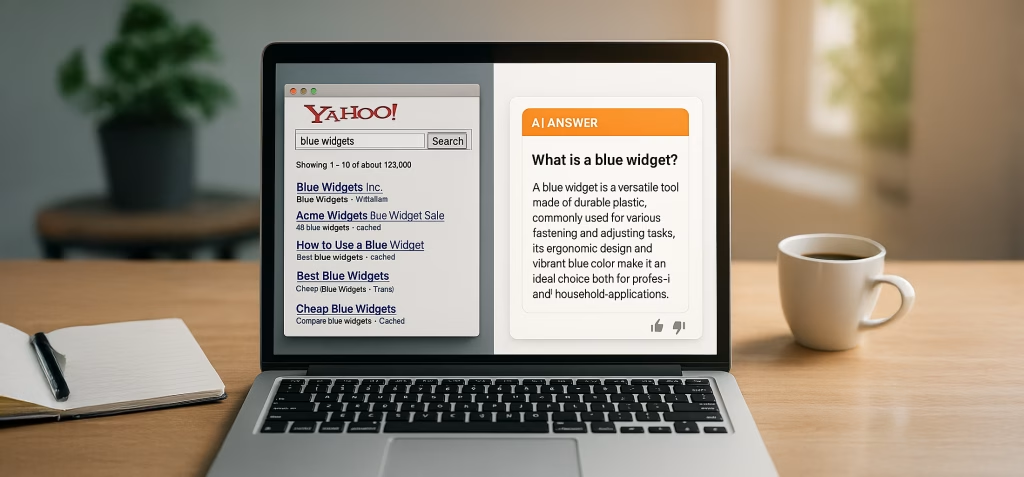By Laurier Mandin

Answer Engine Optimization (AEO) is replacing SEO. Learn how product brands can rank in ChatGPT, Claude, and Gemini, and how Graphos Product can help you lead.
I’ve been helping clients get found for a really long time.
Back in the mid-1990s, I wrote an article for a national business magazine about a new idea called search engine optimization.
That piece won an award. Not because I was some oracle of the Internet (I wasn’t), but because at the time, nobody really knew how search worked. The concept of SEO was that new. The web was a vast, messy bazaar of information. I likened it to the largest library in the world, where all the shelves had been knocked over. You could build the best product in the world, and no one might ever stumble across it.
Three decades later, the same thing is happening again.
Only this time, the gatekeepers aren’t search engines. They’re answer engines: AI-based systems like ChatGPT, Claude, Grok, and Gemini.
Once again, the world is overflowing with noise, and the question for every product maker is the same one I heard in 1996:
How do I make my product easily findable by AI?
What is Answer Engine Optimization (AEO)?
Answer Engine Optimization (AEO) is the process of structuring your website and product content so AI systems (like ChatGPT, Gemini, Claude, and Grok) can easily extract, understand, and trust it when generating answers.
Unlike SEO, which aims to rank your pages in lists of results, AEO aims to make your brand’s information the sourcefrom which those results are written.
When someone asks “What’s the best fiber reinforcement for sustainable concrete?” or “What’s better than a hum-cancelling Strat pickup or a noise gate?”—the goal is for the AI to summarize your product, your data, and ideally, cite your brand.
That’s a tall order if your content isn’t designed for machines to parse it.
In fact, unless you are already a dominant player or exist in a very sparsely populated category, you probably won’t show up at all.
The Shift: From Search Results to AI Answers
Traditional search rewarded keyword density, backlinks, and domain age.
Answer engines reward clarity, context, and authority.
They no longer display ten blue links. They summarize.
And when they summarize, they’re looking for structured, concise, verified facts—not marketing fluff.
Most websites are written for people, not parsers.
That means most brands are invisible to AI-generated answers.
The opportunity window is brief: for the next year or two, the web’s answer graph—the network of sources AI tools trust—is still taking shape.
Product makers who build for visibility now can lock in long-term exposure before citation systems and ranking algorithms harden.

Why Product Companies Can Have an Edge (For Now)
AI models struggle with abstract services but thrive on tangible, factual data: specifications, performance metrics, sustainability claims, and use cases.
That gives product-based businesses (especially those with measurable or certifiable advantages) a massive head start.
If your product:
- Has verifiable data (EPDs, test results, patents)
- Solves a clear problem (e.g., noise, durability, sustainability)
- Can be explained in concise, concrete terms
…you can feed that clarity directly into the answer ecosystem.
Right now, few manufacturers or D2C brands are doing it.
AI systems are hungry for accurate, product-level context. And if you provide it first, you may become the cited source when buyers or specifiers ask related questions.
The Three Pillars of AEO
At Graphos Product, we define three essential components of AEO for physical and digital products:
- Structure — Your content must be machine-readable: schema markup, consistent labeling, alt text, and crawlable product data.
- Substance — Each product page should contain natural-language answers to real buyer questions (“how it works,” “why it’s better,” “when to use it”).
- Sourceability — The information should be easily attributed to you: clear brand voice, citations, and proof points that establish authority.
When these three align, your brand can become answerable — not just findable.
Measuring AI Search Readiness and LL Visibility
Traditional SEO reports measure keywords, backlinks, and traffic.
For AEO, the metric that matters is LL Visibility — short for Large Language Visibility.
What is LL Visibility?
LL Visibility is the degree to which a large language model can see, interpret, and trust your product data when generating an answer.
So, at Graphos, we assess LL Visibility with a five-part scorecard:
- Crawlability:
Can AI systems access and understand your product pages?
→ Structured data, clean sitemaps, no gated specs. - Answerability:
Do you provide clear, complete answers in 2–3 sentences before expanding?
→ Example: “E-Flex 500 improves flexural strength and reduces cracking by 20% compared to untreated concrete.” - Authority:
Are your claims backed by data, certifications, or third-party citations?
→ Awards, lab results, sustainability certifications, patents, media features. - Recency:
Is your information up to date?
→ AI systems favor time-stamped, recently updated pages. - Context Coherence:
Does your site clearly connect each product to its problem, audience, and proof?
→ Pages that read like coherent stories, not fragmented catalogs.
Quick Self-Check for LL Visibility
Try this right now:
Ask ChatGPT or Gemini, “What is [your product name]?”
If the answer is:
- Inaccurate
- Missing altogether
- Or references another product
Your product has low LL Visibility, which means you’re essentially invisible to AI-driven discovery. (What you just did was a branded search, the softest ball of all.)

How to Optimize Your Product for AI Snippets
Answer engines extract data differently from traditional search engines.
They rely on confidence-weighted facts, verified context, and structured Q&A phrasing.
Here’s how to feed them exactly what they need.
1. Write for Questions, Not Keywords
Use the natural phrasing people type or speak:
- “How does this work?”
- “Why is this better?”
- “Is it sustainable?”
- “What’s it made of?”
Then give the short answer first, bolding or isolating it.
Example:
How does the Parallel Pillow reduce heat?
The Parallel Pillow uses TENCEL™ fibers that wick moisture and release heat faster than cotton, keeping the sleeper cooler all night.
2. Use Schema Markup
Add structured data for:
- Product (name, brand, dimensions, materials, price)
- FAQ (Q&A sections)
- HowTo (step-by-step usage or installation)
- Review and AggregateRating (for trust signals)
Google and Gemini use this to confirm accuracy.
ChatGPT and Claude ingest it when scraping for structured context.
3. Include Verifiable Proof
LLMs don’t give a rip about opinions and bold claims. They want evidence.
Include links, test results, and verifiable statistics.
Example:
Tested under ASTM C1609 flexural performance standards.
That’s an anchor fact AI can reuse confidently.
4. Maintain Freshness
Outdated information gets filtered out.
Use “Last updated” timestamps, current-year context, and ongoing blog activity to signal active credibility.
5. Create AI-Friendly Summaries
At the top of key pages, add 50 to 100 words summarizing your product’s function, differentiation, and category fit.
This snippet often becomes the paragraph AI copies or paraphrases.
The Fleeting Advantage Window
Early SEO was a gold rush.
Anyone who mastered backlinks and keywords first dominated for a decade. Often longer.
AEO is that moment again. But it won’t last long.
In the next 12 to 24 months, AI models will mature and begin to freeze portions of their training data.
Once your competitors start optimizing and citation models tighten, your visibility advantage will shrink.
Right now, answer engines are still forming their trusted source networks.
This is the moment to feed them correct, structured, verified product data that aligns with your positioning.
If you wait until “everyone is doing AEO,” you’ll face the same diminishing returns SEO has today.
How AEO Changes Marketing for Product Brands
- Content Becomes a Product Asset
Every fact, diagram, or data table is potential source material for AI… essentially “distributable expertise.” - Transparency Outranks Persuasion
Algorithms favor brands that show their work (proof, specs, origins, sustainability data). - Authority Requires Verification
Reviews, EPDs, and credible certifications matter more than catchy copy. - Short Answers Win Long Queries
In the age of conversational AI, clarity beats charisma.
How Graphos Product Can Help
Graphos Product helps innovators build visibility from the ground up… through positioning, proof, and precision.
Our AEO services integrate seamlessly with your go-to-market strategy:
1. AEO Readiness Assessment
We measure your current LL Visibility, identifying gaps in crawlability, structure, and content clarity.
You’ll get to see how your brand performs against competitors in emerging AI discovery.
2. AEO Strategy & Implementation
We craft a tailored plan to make your content answer-ready:
- Restructure product pages and FAQs
- Write question-driven copy
- Implement schema markup
- Integrate performance data and citations
3. Monitoring & Reporting
We track which models mention or summarize your brand, and how often your site appears in AI responses or overviews.
4. Ongoing Optimization
As new AI engines evolve, we adapt your content for the latest retrieval methods, ensuring long-term authority.
At Graphos, we’ll help you own the answers before your competitors even realize they’re missing the boat.

How to Start Building YOUR AEO Foundation
- Audit your site for structure and clarity.
Can each product page stand alone as a complete answer? - Add or refine schema markup.
Even a few Product and FAQ elements can make a major difference. - Create an “Answers” section.
A repository of short, well-written Q&As about your products and industry: an AEO goldmine. - Feed accuracy into every channel.
Consistent facts across your website, datasheets, and press materials train AI to trust your data. - Refresh quarterly.
Timestamp updates and republish with new examples, stats, or insights.
The Future of Visibility Belongs to the Clear
Search was for being seen.
AEO is about being understood. (Or Grok’d, to borrow a term Elon Musk borrowed from Robert A. Heinlein.)
As answer engines take over, the brands that explain themselves best (clearly, consistently, and credibly) will dominate AI-generated answers.
The rest will vanish behind paraphrased summaries of their better-prepared competitors.
Want to make YOUR product the answer?
That’s what we do as product marketing consultants at Graphos Product, helping innovators get found, trusted, and chosen in the age of AI search.




